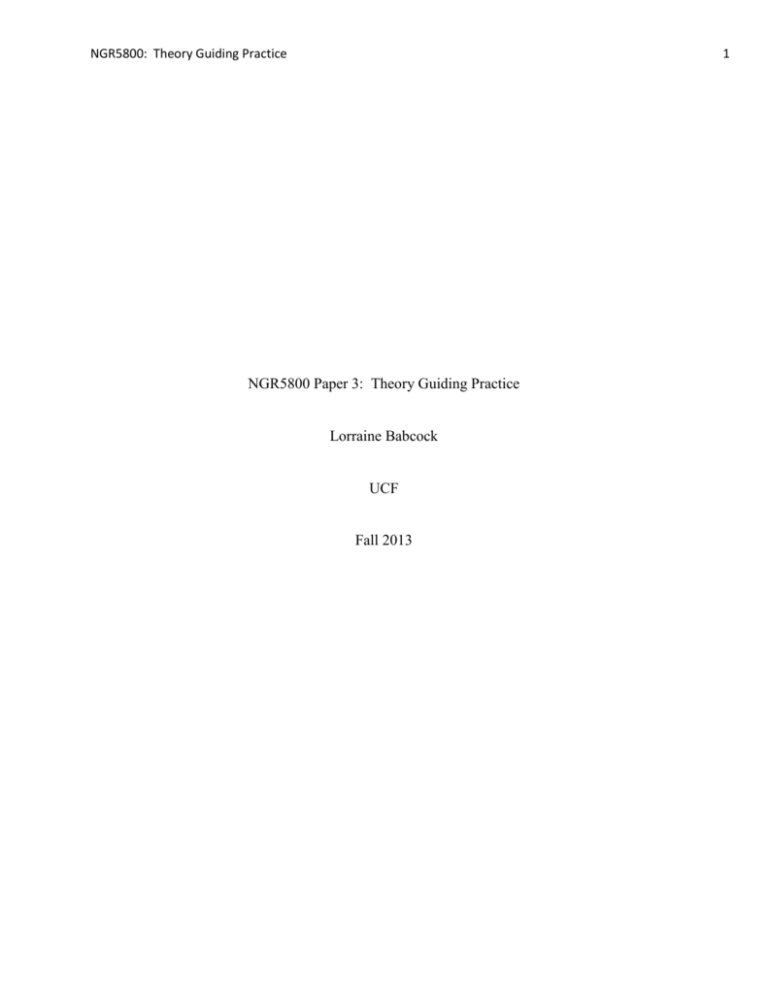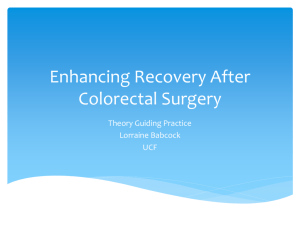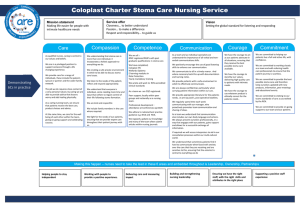NGR 5800- Paper 3 Theory Guiding Practice
advertisement

NGR5800: Theory Guiding Practice 1 NGR5800 Paper 3: Theory Guiding Practice Lorraine Babcock UCF Fall 2013 NGR5800: Theory Guiding Practice 2 Abstract As previously discussed, cognitive adult patients who have had stoma surgery present multifaceted challenges for nursing. The objective of nursing is to enhance a safe and quick recovery, with assurance of the patient’s ability to perform self-care once discharged. Although an inpatient nurse may not be a comprehensive expert regarding stoma patients, they have expertise on the subjects of coping interventions and stress reduction. Inflammatory bowel disease is estimated to affect as many as 1.4 million people in the United States. Both the patient and surgeon are dependent upon the nurse to achieve positive outcomes. Coping and education may be impaired in this patient population (Babcock, 2013). Through application of the Theory of Self-Efficacy, nurses can reduce the patient’s stress and anxiety to facilitate effective education of self-care for discharge home. NGR5800: Theory Guiding Practice 3 Background Cognitive adult patients who have had stoma surgery present multifaceted challenges for nursing. Many colorectal surgeons are now practicing an enhanced recovery program of standardized post-operative orders designed to reduce recovery time (Aasa, Hovbäck , & Berterö, 2013). The optimal length of stay is two to three days, but high stress and anxiety levels often hinder the patient’s self-care and education. The nurse must develop a plan of care that addresses coping and health maintenance while also being mindful of the financial implications regarding extended lengths of stay (Babcock, 2013). McEwen and Wills advocate that in order “to provide comprehensive, holistic, and effective interventions, nurses should rely on sound theoretical principles to develop and implement the plan of care” (2011, p. 390). In the case of the stoma population, the nurse can use multidisciplinary concepts as theory is applied to practice (McEwen & Wills, 2011). This patient population will likely be apprehensive about how they will live their life after discharge (Readding, 2005). The role of inpatient nursing is to make sure the patient possesses basic selfcare skills, knowledge, and knows how to access resources to prevent future complications and/or readmission (Readding, 2005). Pre-hospitalization initiation of patient education is advantageous (Readding, 2005). Inpatient nurses may not have extensive knowledge regarding stoma patients, but they do have expertise on the subjects of coping interventions and stress reduction. Stoma patients have feelings of uncertainty and feelings of not being in control. Emphasis should be placed on teaching the patient coping strategies (Danielson, Soerensen, Burcharth, & Rosenberg, 2013). To achieve positive, optimal outcomes, the surgeons and patients rely upon nursing. NGR5800: Theory Guiding Practice 4 Statement of the Clinical Problem Adult stoma patients with normal intellect experience ineffective health maintenance related to impaired knowledge regarding integration of stoma care into their lifestyle (Ackley & Ladwig, 2006). The essence of this problem is motivation and changing behavior. Significance of the Problem As stated in my previous paper, Crohn’s disease and ulcerative colitis are inflammatory bowel diseases (IBD) that can cause pain, cramping, altered elimination, fatigue, and malnutrition (Mayo Clinic, 1998-2013). Patients usually require healthcare throughout their life; there is no medical cure (CDC, 2012). Inflammatory bowel disease affects as many as 1.4 million people in the United States (CDC, 2012). Ten percent of patients are under the age of 18; peak onset of IBD usually occurs between 15-30 years of age (CDC, 2012). In both adults and children, a focus on education and coping is beneficial (Borkowski, 1998). Colorectal surgical intervention is necessary when symptoms of IBD are no longer controlled by medical management (Allison, Lindsay, Gould, & Kelly, 2013). IBD has “an overall health care cost of more than $1.7 billion” (CDC, 2012). Over 100,000 hospitalizations per year are due to IBD (CDC, 2012). “In order for a patient to comprehend and retain information, they must be at low levels of stress and anxiety” (Babcock, 2013). Because nurses know how to help patients cope and because they are skilled at education, they are the key to success where this patient population is concerned. To verify effective patient education and comprehension, return demonstration and the teach-back methods have been used (Peter & Robinson, 2011). Mindfulness training may also be helpful. Trunnell states mindfulness is “being nonjudging, having a beginner’s mind, NGR5800: Theory Guiding Practice 5 being trusting, nonstriving, accepting, and letting go” (Trunnell, 1996). Research also supports that active coping strategies used to change self-efficacy are healthier than avoidant coping strategies (Krouse, et al., 2009). Specific Aims Nurses have an opportunity to help improve patient outcomes by applying the middle range theory of self-efficacy to get the patient prepared for discharge. The Theory of SelfEfficacy will address the core problems of motivation and changing behaviors. The goal is to use the critical elements of shared decision making, teamwork, and communication to design successful plans of care for integrating stoma care into the life of the patient. The patient, family, providers, and nursing should be involved. Specific examples of how to accomplish this goal will be further explored in the theory application section below. Theory / Conceptual Framework / Model Self-efficacy is the individual’s own recognition of his or her ability to take action (Smith & Liehr, 2014). The Theory of Self-Efficacy is based on the social cognitive theory (Smith & Liehr, 2014). The two vital concepts of the theory are self-efficacy expectations and outcome expectations (Smith & Liehr, 2014). In other words, the individual has to believe they are capable of causing a certain outcome. The environment and the interaction with others in the environment are influential as well. The Theory of Self-Efficacy is a middle range theory of nursing as it meets the evaluation framework of substantive foundations, structural integrity, and functional adequacy. The theory is within the discipline of nursing and the concepts are clearly defined. There are no more NGR5800: Theory Guiding Practice concepts than needed to explain the phenomenon and they are logically represented with a model. The theory is applicable in a variety of environments and settings (Smith & Liehr, 2014). Application of the Theory to the Problem Self-efficacy conclusions are based on four sources: enactive attainment, vicarious experience, verbal persuasion, and physiological feedback during a behavior (Smith & Liehr, 2014, p. 201). To apply the Theory of Self-Efficacy to the problem of integrating stoma care into the patient’s lifestyle, nursing can focus on each of the informational sources. Examples of enactive attainment, otherwise described as the performance of a behavior, is the most influential source (Smith & Liehr, 2014). A specific action towards enactive attainment would be to set a goal that the patient and family will be able to return demonstrate care of the stoma or incision by postoperative day two. Another way to encourage enactive attainment would be to have the patient and family participate in developing the plan of care; this can begin before hospitalization. Multidisciplinary participation in the plan of care should include the patient and family and is accomplished with shared decision making; it also helps to decrease patient anxiety (Singh, Butow, Charles, & Tattersall, 2010). Through the informational source of vicarious experience, the patient and family can visualize others performing the same behavior identified in the goals. The patient and family should be given resources (via networking and/or literature) so they can see how others have dealt with the same situation. Case management, nursing, and providers may all be in the position to offer resources before and during hospitalization. Another source of information is mentoring and motivating; otherwise considered verbal persuasion (Smith & Liehr, 2014). 6 NGR5800: Theory Guiding Practice Verbal persuasion can be achieved when nursing staff and providers give verbal encouragement and support the patient’s efforts. Physiological feedback during a behavior is when individuals consider how they feel physically; if they feel ill or are in pain, they may decide not to display the desired behavior (Smith & Liehr, 2014). Nursing must establish goals related to physical function. An example would be the goal to maintain pain at an acceptable level through the use of relaxation techniques and non-opioid medications. Additional goals would be for the patient to comply with a walking schedule and early nutrition schedule. Research has shown improved self-efficacy, reduced pain, and reduced anxiety the earlier the patient is provided education (Wong, Chan, & Chair, 2010). A goal for nursing would be to maintain an even or euvolemic fluid balance throughout the hospitalization. 7 NGR5800: Theory Guiding Practice 8 Summary and Conclusions Adult stoma patients with normal intellect or cognition often have difficulty incorporating their stoma care into their lifestyle after discharge. Stress and anxiety may hinder how quickly the patient retains knowledge as well as how effectively they are able to cope with the changes they are experiencing, resulting in problems with motivation and changing behavior. With the increased implementation of enhanced recovery programs, the objective is discharge on post-operative day two or three; often it is difficult to meet this objective due to the complexities of the patient population. The goal is to ready the patient and family for a safe discharge home. Although every nurse may not be proficient in the care of stoma patients, they are very skilled at assisting with coping strategies and patient education. Through the application of the Theory of Self-Efficacy, the actions of the nurse can effect positive outcomes, where the patient is motivated and able to change behaviors. NGR5800: Theory Guiding Practice 9 References Aasa, A., Hovbäck , M., & Berterö, C. M. (2013, June). The importance of preoperative information for patient participation in colorectal surgery care. Journal of Clinical Nursing, 22(11-12), 1604-1612. Ackley, B. J., & Ladwig, G. B. (2006). Nursing Diagnosis Handbook (8th ed.). St. Louis, Missouri: Mosby Elsevier. Allison, M., Lindsay, J., Gould, D., & Kelly, D. (2013, November). Surgery in young adults with Inflammatory Bowel Disease: A narrative account. International Journal of Nursing Studies, 50(11), 1566-1575. Babcock, L. (2013, October 25). NGR5800: Paper 2 Analysis of a Nursing Problem. Borkowski, S. (1998). Pediatric stomas, tubes, and appliances. The Pediatric Clinics of North America, 45(6), 1419-1435. CDC. (2012). Inflammatory Bowel Disease. Retrieved from Centers for Disease Control and Prevention: http://www.cdc.gov/ibd/ Danielson, A. K., Soerensen, E. K., Burcharth, K., & Rosenberg, J. (2013, January). Impact of a temporary stoma on patients’ everyday lives: feelings of. Journal of Clinical Nursing, 22(9-10), 1343-1352. Krouse, R. S., Grant, M., Rawl, S. M., Mohler, M. J., Baldwin, C. M., Coons, S. J., et al. (2009, March). Coping and acceptance: The greatest challenge for veterans with intestinal stomas. Journal of Psychosomatic Research, 66(3), 227-233. Mayo Clinic. (1998-2013). Inflammatory bowel disease. Retrieved from Mayo Foundation for Medical Education and Research: http://www.mayoclinic.com/health/inflammatorybowel-disease/DS01195/DSECTION=symptoms McEwen, M., & Wills, E. M. (2011). Theoretical Basis for Nursing (3rd ed.). Philadelphia, PA: Lippincott Williams & Wilkins. Peter, D., & Robinson, P. (2011, October). Teach-back technique must be taught. Patient Education Management, 18(10), 112-113. Readding, L. A. (2005, September). Hospital to home: smoothing the journey for the new ostomist. British Journal of Nursing, 14(16), S17-S20. NGR5800: Theory Guiding Practice Singh, S., Butow, P., Charles, M., & Tattersall, M. H. (2010, September). Shared decision making in oncology: assessing oncologist behaviour in consultations in which adjuvent therapy is considered after primary surgical treatment. Health Expectations. Smith, M. J., & Liehr, P. R. (2014). Middle Range Theory for Nursing (3rd ed.). New York: Springer Publishing Company. Trunnell, E. P. (1996, January). Mindfulness and people with stomas. Journal of Wound, Ostomy and Continence Nursing, 23(1), 38-45. Wong, E. M.-L., Chan, S. W.-C., & Chair, S.-Y. (2010, May). Effectiveness of an educational intervention on levels of pain, anxiety, and self-efficacy for patients with musculoskeletal trauma. Journal of Advanced Nursing. 10






